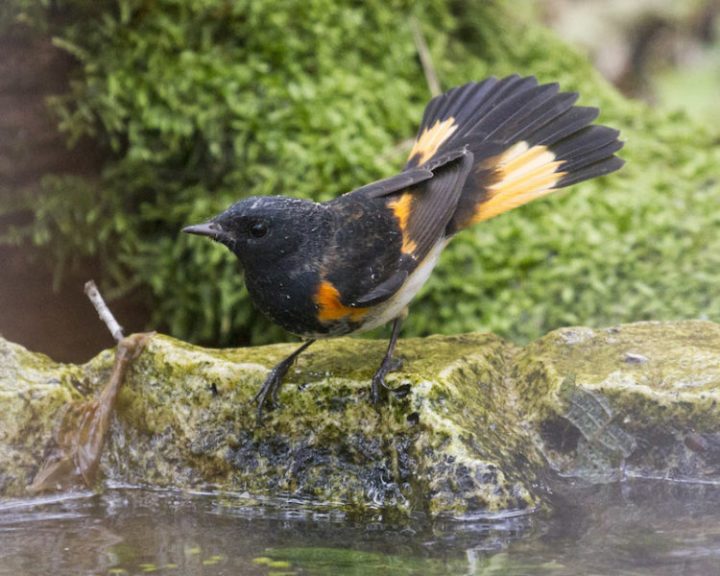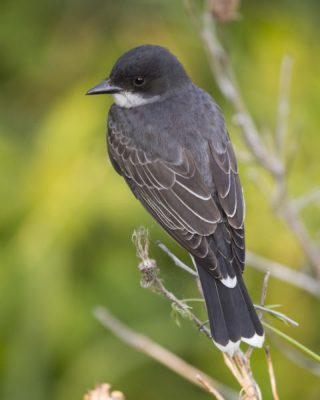
Reprinted from the Outer Banks Voice
OUTER BANKS — Fall migration is a magical time for birders.
Supporter Spotlight
We weather the summer heat and eagerly turn the calendar pages while we anticipate clear fall mornings, cold fronts and trees dripping with warblers.
Amateur meteorologists, we study the weather maps and wait for the right forecast. Over and over, the long range forecast looks good, then changes at the last minute. Northeast or southerly winds will just not suffice.
Of course, we arrive too early; we always do. The sun is still down and the skies seem empty. But then we hear it — that first call note, a tiny “zeet” — a warbler. Soon followed by another and another.
Migrants are coming in. Many birds are high, and can’t be identified; some fly right by us, within arm’s reach. Others drop down into the shrubs like pellets of hail. Frustration and joy at the same time.
The day awakens and soon we are looking at warblers, orioles, flycatchers, and vireos, some in flight and others perched here and there in trees, shrubs and even on the ground. Some linger for two minutes – some for two seconds, so we quickly get on them with our binoculars.
Supporter Spotlight
A yellow warbler here, an American redstart there and a trio of Baltimore orioles in the distant snag. Several bobolinks just flew over, calling.
The orioles are gone now and have been replaced by an eastern kingbird — and here come three more. Now another oriole lands, flushing the kingbirds; this one’s an adult male — such a gorgeous bird. And a small green bird just disappeared into the bushes right in front of us. Maybe a vireo?
This frantic action goes on for a couple of hours, then the birds are gone.
Part of the fun is simply seeing and identifying the colorful migrants.
One of the goals is searching for unusual species. One of the most fascinating things is just getting caught up in the migration, feeling the energy of it all.
Where did these awesome birds come from? When did they leave? How far did they travel last night to get here? Why did they come to this exact spot at this exact time? Where are they headed next?
So what exactly is fall migration and how can birders predict which days will be best?

Many species of birds are permanent residents. They stay put year-round. Good examples are some of our backyard birds: cardinals, mourning doves, towhees and chickadees.
Many other species have a home base, but move each spring to a better place to breed — a location where food is abundant when the eggs hatch. Each species has its own location, habitat requirements and its own schedule, requirements for successful breeding that are passed down from generation to generation.
Let’s look at wood-warblers, a colorful and popular group of birds.
Most of our migrant warblers nest in North America and/or Canada but spend the rest of the year in the West Indies, Central America or South America. Quite a round trip for birds the size of chickadees.
Blackpoll warblers, for a great example, fly from the boreal forests of Northern Canada all the way to eastern South America, often in a nonstop flight over the Atlantic Ocean of almost 1,800 miles in three days. Not bad for a bird weighing in at just 12 grams and measuring 5½ inches long. Some blackpolls even make the trip from Alaska, crossing the entire continent before reaching the ocean.
In fall, when nesting is over and it’s time to head home, warblers wait for the right conditions to make the journey easier. They prefer to migrate at night, for several reasons. First, to avoid predators. Second, because temperatures are normally cooler and skies less turbulent at night, making navigation easier. Third, because food is easier to find during the day, so they stop then to “refuel.” Migrants also prefer a tailwind to help push them along, saving energy. Since they are flying south in fall, this means they need a north wind.
They have complex, predetermined routes, but their timing is about the same each year, so they are fairly predictable. This helps birders know when to look.
What is important to birders on the Outer Banks is that one of the routes that many songbirds take during fall migration is along the Atlantic coast. On those occasions when the north winds that are aiding their migration are actually out of the northwest, the birds are sometimes pushed out to sea during the night.
Morning arrives and (yikes!) the birds realize that they have no land on which to stop, rest and refuel, so they turn around and fly back in the direction from which they came, northwest, to try and get back on track.
When they finally reach land, if they do, they are often exhausted and drop down into the first vegetation they find to rest. This is the scenario that enables birders to see so many songbirds first thing in the morning after a strong northwest wind.
So where are these “hot spots” for songbird migrants? The north end of Pea Island, the dikes between the impoundments at Pea Island, the north end of Roanoke Island, the sound front in Duck and in the village of Corolla, near the lighthouse.
Other spots that can be good are Bodie Island woods and Nags Head Woods, although there are a lot of habitats available there for birds to disperse. Sunny edges of habitat are generally good spots to try, rather than deep in the woods, especially in the morning.

Birding for shorebirds can also be great in September, with around 35 species possible. Best bets are mudflats around the inlets or impoundments. Water levels make a huge difference.
If the impoundments are high, shorebirds can be harder to find. If water levels are low, check Mattamuskeet — the impoundments and the lake itself. If rainfall has been plentiful, check out any flooded lawns: Bodie Island, Wright Brothers, the Manteo Airport, turf farms, even campgrounds can hold birds.
Several species of ducks migrate to the Outer Banks in September. Scope the local impoundments for gadwall, American wigeon, American black duck, mallard, blue-winged teal, northern shoveler, northern pintail and green-winged teal.
Wetland birds to look for in September are pied-billed grebe, American bittern, Virginia rail, sora and American coot.
Raptors that show up in September include northern harrier, sharp-shinned hawk, American kestrel, merlin and peregrine falcon, especially later in the month.
At home, keep those feeders and water features clean and filled. During fall migration there is no telling what may show up.
This story is provided courtesy of the Outer Banks Voice, a digital newspaper covering the Outer Banks. Coastal Review Online is partnering with the Voice to provide readers with more environmental and lifestyle stories of interest about our coast. You can read other stories about the Outer Banks here.







